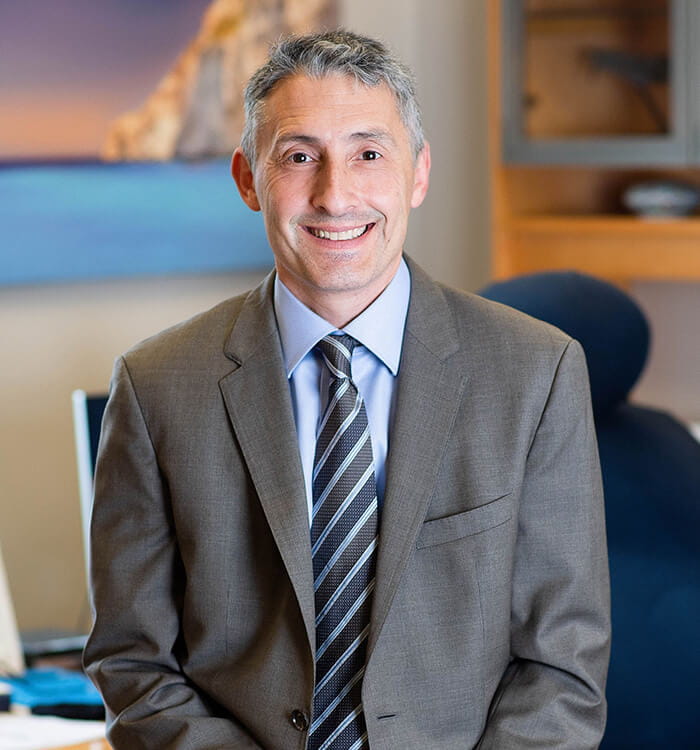International Review Raises Concerns Over Studies of Intracranial Aneurysm Treatment
December 05, 2023
Innovations in Neurology & Neurosurgery | Fall 2023
Sepideh Amin-Hanjani, MD, PhD, recently joined an international team to conduct a meta-analysis of scientific studies evaluating emerging intracranial aneurysm (IA) treatments. Published in the Sept. 1 JAMA Network Open, their findings raise concerns over endovascular devices labeled “safe and effective” that lack rigorous evidence or sufficient control groups.
 Sepidah Amin-Hanjani, MD
Sepidah Amin-Hanjani, MD Nicholas Bambakidis, MD
Nicholas Bambakidis, MDLed by Neurosurgeon Victor Volovici, MD, PhD, of Erasmus University Medical Center in Rotterdam, Netherlands, the team included experts from University Hospitals Cleveland Medical Center, Case Western Reserve University, the Mayo Clinic, the Barrow Neurological Institute and the University of South Carolina.
“Dr. Amin-Hanjani is a world-renowned expert in cerebrovascular disease and aneurysm treatment,” says Nicholas C. Bambakidis, MD, Chair of the Department of Neurological Surgery, Director and Vice President of the University Hospitals Neurological Institute, and Harvey Huntington Brown Jr. Chair in Neurosurgery at Case Western Reserve University School of Medicine. “Her collaboration on this significant international project points to the groundbreaking research that the UH Neurologic Institute is engaging in when it comes to cerebrovascular disease, stroke prevention and discussions of potential pitfalls of technological advancement if not done carefully and thoughtfully.”
A systematic review of 1,356 international studies encompassing over 410,000 patients with brain aneurysm revealed concerning shortcomings. “Methodological flaws and incomplete outcomes reporting called into question claims of the safety, effectiveness or durability of IA treatment,” says Dr. Amin-Hanjani, Vice Chair of the Department of Neurological Surgery, University Hospitals Cleveland Medical Center, and Professor of Case Western Reserve University School of Medicine. “This was an opportunity to participate in a project we thought was important to highlight how these devices are represented in the literature and the resulting implications for patient care.”
Troublesome Findings
A blinded academic review found no difference in patient outcomes between studies claiming a technique was safe, uncertain or unsafe. Similarly, there was no difference in the proportion of IAs completely occluded at last follow-up between studies claiming a technique was effective, uncertain or noneffective. Only one study defined a threshold for a technique to be considered unsafe.
Additional study shortcomings identified by the team of experts included:
- A lack of methodological rigor
- Less than 2 percent of studies reported a definition of safety, effectiveness or durability
- Incomplete reporting of outcomes in 546 studies (40 percent)
- Insufficient current or historical control groups
Recommendations
The authors of the meta-analysis recommended a thorough evaluation of evidence used in support of recent devices. Additionally, the team highlighted the crucial need for stringent peer review of scientific manuscripts and a willingness to call out or reject publication of studies shown to lack sufficient methodology.
“Ongoing innovation of endovascular devices has an important role in advancing treatment options for aneurysms, but we need to ensure that new treatments are appropriately benchmarked to existing strategies, including surgery,” says Dr. Amin-Hanjani. “Although it can be difficult to establish concurrent control studies for new devices from a feasibility or expense perspective, there are methods to more rigorously compare outcomes to historical or concurrent controls when substantiating statements about safety and efficacy.”
Optimizing IA Treatment
Best practices treatment for IA has traditionally relied on neurosurgical clipping or endovascular coiling. In recent years, industry has brought to market new techniques such as the Woven EndoBridge (WEB) devices and flow-diverting stents. While all devices for the treatment of IA within the U.S. are regularly monitored for safety and efficacy, current evidence does not support that emerging therapies offer reliably better or worse outcomes than clipping or coiling.
“Treatment decisions should continue to rely on multidisciplinary consultation and individualized care plans based on the size and location of the aneurysm, along with patients’ preferences, age and overall health,” says Dr. Amin-Hanjani.
For more information, contact Dr. Amin-Hanjani at Sepideh.Hanjani@UHhospitals.org.
Contributing Experts:
Sepideh Amin-Hanjani, MD, PhD
Vice Chair, Department of Neurological Surgery
University Hospitals Neurological Institute
University Hospitals Cleveland Medical Center
Professor
Case Western Reserve University School of Medicine
Nicholas C. Bambakidis, MD
Vice President and Director
University Hospitals Neurological Institute
Harvey Huntington Brown, Jr. Chair in Neurosurgery
University Hospitals Cleveland Medical Center
Professor
Case Western Reserve University School of Medicine


